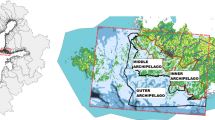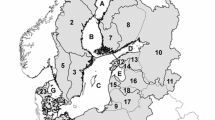Abstract
There is an urgent need to control nutrient discharges into coastal aquatic systems because they are one of the main anthropogenic environmental impacts on coastal seas. Efficient management of nutrient fluxes in the coastal zone requires a sound scientific basis. This involves research on the dynamics of natural and social systems. In this paper some concepts and tools are discussed which are currently available in ecology and economics to preserve the aquatic environment. In ecology, knowledge of ecosystem functions and responses to human perturbations at the ecosystem level is more advanced than at the community level. Therefore, the biological integrity approach as the primary management goal is a more useful concept than the biological diversity approach.
Economics is the necessary link between the environmental issue that is caused by human activity and the deduction of an environmental policy that addresses the origin of these issues. Different approaches of selecting cost-minimal solutions and optimal levels of environmental quality, as well as different categories of environmental goods, are discussed.
Ecological and economic sciences are mainly referring to regional situations. Hence Integrated Coastal (Zone) Management (IC(Z)M) strategies are case-specific and basically local. However, the main challenge of ICZM research is to handle the variety of temporal and spatial scales of natural and social systems in order to obtain a comprehensive description of processes controlling nutrient dynamics in the coastal zone which can be used by decision-makers.
Similar content being viewed by others
Abbreviations
- ICM:
-
Integrated Coastal Management
- ICZM:
-
Integrated Coastal Zone Management
References
Anon. 1990.Biological criteria: national programme guidance for surface waters. Report EPA-440/-90-004. EPA, Office of Water, Washington, DC.
Anon. 1996.LOICZ biogeochemical modelling guidelines, LOICZ Reports & Studies 5. NIOZ, Texel.
Anon. 1998.Water in beeld. CWI, Commission on integrated Water Management. RIZA, Lelystad.
Angermeier, P.L. & Karr, J.R. 1994. Biological integrity versus biological diversity as a policy directives: protecting biotic resources.Bioscience 44: 690–697.
Begon, M., Harper, J.L. & Townsend, C.R. 1996.Ecology. Blackwell Science, Oxford.
Bodeanu, N. 1993. Microbial blooms in the Romanian area of the Black Sea and contemporary eutrophication conditions. In: Smayda, T.J. & Shimizu, Y. (eds.)Toxic phytoplankton blooms in the sea, pp. 203–209. Elsevier, Amsterdam.
Coase, R.H. 1960. The problem of social cost.J. Law Econ. 3: 1–44.
Caddy, F. & Griffiths, R.C. 1990.A perspective on recent fishery-related events in the Black Sea. Studies and Reviews 63, pp. 43–71. General Fisheries Council for the Mediterranean. FAO, Rome.
Cociasu, A., Dorogan, L., Humborg, C. & Popa, L. 1996. Long-term ecological changes in the Romanian coastal waters of the Black Sea.Mar. Poll. Bull. 32: 32–38.
Costanza, R., dÕArge, R., de Groot, R., Farber, S., Grasso, M., Hannon, B., Limburg, K., Naeem, S., OÕNeill, R.V., Paruelo, J., Raskin, R.G., Sutton, P. & van den Belt, M. 1997. The value of the worldÕs ecosystem services a natural capital.Nature 387: 253–260.
Ehler, C.N. 1993. Integrated coastal ocean space management: challenges for the next decade.COSU III, the third international symposium on coastal ocean space utilization. Santa Margherita Ligure, Portofino.
Elmgren, R. 1984. Trophic dynamics in the enclosed, brackish Baltic Sea.Rapp. P.-V. Reun. Cons. Int. Explor. Mer. 183:149–166.
Fennel, W & Neumann, T. 1996. The mesoscale variability of nutrients and plankton as seen in a coupled model.Ger. J. Hydrogr. 48: 49–71.
Gomoiu, M.-T. & Tiganus, V. 1990. Elements pour connaissance de lÕetat et de lÕ <Revolution des communaut Rebenthiques de lÕouest de la Mer Noire.Rapp. Comm. Int. Mer Medit. 32: 24.>
Goudi, A. 1994.The human impact on the natural environment. MIT Press, Cambridge, MA.
Grossman, G.M. & Krueger, A.B. 1994.Economic growth and the environment. Discussion Paper in Economics No. 167, Princeton, NJ.
Heip, C. 1995. Eutrophication and zoobenthos dynamics.Ophelia 41: 113–136.
Humborg, C., Ittekkot, V., Cociasu, A. & von Bodungen, B. 1997. Effect of Danube River Dam on biogeochemistry and ecosystem structure of the Black Sea.Nature 386: 385–388.
Karr, J.R. & Dudley, D.R. 1981. Ecological perspectives on water quality goals.Environ. Manage. 5: 55–68.
M Sler, K.-G. 1991. Incentives in international environmental problems. In: Siebert, H. (ed.)Environmental scarcity: the international dimension, pp. 75–93. Mohr, TŸbingen.
Martin, J.-M., Burton, J.D. & Eisma, D. 1981.River inputs to ocean systems. UNEP, IOC, SCOR, New York, NY.
Mee, L.D. 1992. The Black Sea in a crisis: a need for concerted international action.Ambio 21: 278–285.
Mitchell, R.C. & Carson, R.T. 1989.Using surveys to value public goods. The contingent valuation method. Resources for the future. Washington, DC.
Nixon, S.W. 1995. Coastal marine eutrophication: A definition, social causes, and future concerns.Ophelia 41: 199–219.
Nixon, S.W., Oviatt, C.A., Frithsen, J. & Sullivan, B. 1985. Nutrient and the productivity of estuarine and coastal marine ecosystems.J. Limnol. Soc. S. Afr. 12: 43–71.
Odum, E.P. 1992. Great ideas in ecology for the 1990s.Bioscience 42: 542–545.
Olson, M 1965.The logic of collective action. Harvard University Press, Cambridge, MA.
Schindler, D.W. 1990. Experimental perturbations of whole lakes as a test of hypotheses concerning ecosystem structure and function.Oikos 57: 25–41.
Service, M., Durrant, A.E., Mills, J.A., Taylor, J.E. & Faughey, D. 1996. The trophic status of two northern Irish Sea loughs.J. Coastal Conserv. 2: 159–168.
Shrader-Frechette, K.S. & McCoy, E.D. 1995.Methods in ecology, Cambridge University Press, Cambridge.
Siebert, H. 1992.Economics of the environment. 3rd ed. Springer, Berlin.
Smayda, T.J. 1990. Novel and nuisance phytoplankton blooms in the sea: Evidence for a global epidemic. In: Graneli, E., Sundstršm, B., Edler, L. & Andersson, D.M. (eds.)Toxic marine phytoplankton, pp. 29–40. Elsevier, Amsterdam.
Staras, M. 1999. Fishery in relation to the environment in the Danube delta biosphere reserve. In: Nijland, H.J. (ed.)Dealing with nature in deltas, pp. 157–168. RIZA, Rijkswaterstaat, Lelystad.
Stiegebrandt, A & Wulff, F. 1987. A model for nutrients and oxygen in the Baltic proper.J. Mar. Res. 45: 729–759.
Stršbele, W.J. 1991. Institutional arrangements for transfrontier river pollution. In: Siebert, H. (ed.)Environmental scarcity: the international dimension, pp. 139–158. Mohr Verlag, TŸbingen.
Tilman, D. & Downing, J.A. 1994. Biodiversity and stability in grasslands.Nature 367: 363–365.
Tolmazin, D. 1985. Changing coastal oceanography of the Black Sea. I: The northwestern shelf.Progr. Oceanogr. 15: 217–276.
van Bennekom, A.J. & Salomons, W. 1981. Pathways of nutrients and organic matter from land to the ocean through rivers. In: Martin, J.-M., Burton, J.D. & Eisma, D. (eds.)River inputs to ocean systems, pp. 33–51. UNEP, IOC, SCOR, New York, NY.
Vollenweider, R.A., Marchetti, R. & Viviani, R. 1992.Marine coastal eutrophication. Elsevier, Amsterdam.
Wittgren, H.B. & Arheimer, B. 1995.Source apportionment of riverine nitrogen transport based on catchment modelling. DIFusePOL Õ95, 2nd International IAWQ Specialized Conference and Symposia on Diffuse Pollution, Pt. II: 332–338. Brno & Prague.
Wulff, F. & Niemi, A. 1992. Priorities for the restoration of the Baltic Sea—a scientific perspective.Ambio 21: 193–195.
Wulff, F., Field, J.G. & Mann, K.H. 1989.Network analysis in marine ecology. Springer, Berlin.
Author information
Authors and Affiliations
Corresponding author
Rights and permissions
About this article
Cite this article
Christoph, H., Christian, K. Integrated coastal management from the perspective of nutrient control. J Coast Conserv 5, 135–144 (1999). https://doi.org/10.1007/BF02802750
Received:
Revised:
Accepted:
Issue Date:
DOI: https://doi.org/10.1007/BF02802750




